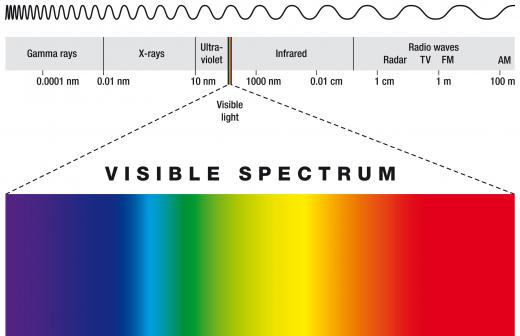What is a Photon?
A photon is a type of elementary particle that forms the basic unit of electromagnetic radiation, which includes radio waves, infrared, visible light, ultraviolet, X-rays, and gamma rays. Photons have no mass, no electric charge, and travel at the speed of light. Unlike some particles, like protons and neutrons, they are not thought to be made up of smaller components. They belong to a class of particles that are responsible for the fundamental forces of nature, and carry the electromagnetic force. According to the theory of quantum electrodynamics, the way electrically charged particles behave toward one another can be described in terms of photons.
Experiments carried out in the 19th century seemed to prove that light was composed of waves. Early in the 20th century, however, other experiments indicated that it was made up of particles. Although it seems contradictory, light and other forms of electromagnetic radiation actually behave as both forms. Photons are particles of light, but they also have wave-like properties, such as wavelength and frequency.
Photons and Matter

Matter can interact with particles of light in a number of ways. An electron in an atom, for example, can absorb a photon, causing it to jump to a higher energy level. In time, the electron may return to a lower energy level, emitting the extra energy as a photon. The eye is able to detect light because certain molecules in the retina absorb energy from photons within the visible light range of frequencies. This energy is converted into electrical impulses that travel along the optic nerve into the brain.

In some cases, electrons can absorb relatively high-energy particles of ultraviolet light then emit the energy as longer wavelength photons of visible light, a phenomenon known as fluorescence. Molecules can absorb energy at infrared frequencies, which causes them to move around more, resulting in an increase in temperature; this is why objects can be heated by sunlight or by an electric heater. Very high-energy photons, such as X-rays and gamma rays, can have a destructive effect on matter. They have enough energy to remove electrons from atoms, forming positively charged ions, and to break chemical bonds. These effects cause chemical changes that can be very damaging to living organisms.
Discovery

The concept and discovery of the photon are closely tied to the development of quantum theory. Around 1900, theoretical physicist Max Planck found a solution to a problem that had troubled scientists for some time, involving the frequencies of electromagnetic radiation emitted by an object at various temperatures. He proposed that energy came in small, indivisible units, which he termed quanta. Albert Einstein’s work on the photoelectric effect in 1905 provided strong experimental evidence that quanta were real. It was not until 1926, however, that the term “photon” was first used — by the chemist Gilbert N. Lewis — to describe quanta of light.
Energy and Frequency

Planck showed how the energy of a quantum of light is related is related to its frequency. He defined a constant, known as Planck’s constant, which, when multiplied by the frequency of a light quantum, gives its energy. High frequency photons, such as those of X-rays, therefore have more energy than those of low frequencies, such as radio waves. Planck’s constant is extremely small; however, most sources of light produce enormous numbers of these particles, so the total energy may be considerable.
Quantum Electrodynamics
As quantum theory developed, it became apparent that the forces of nature must be carried in some way by agents that could not travel faster than light, and that these agents must be “quantized”: they could exist only as multiples of indivisible units. The relationship between light, electricity, and magnetism had already been made clear in the 19th century. At that time, however, light and other forms of electromagnetic radiation were assumed to consist of waves. Following the discovery of photons, a new theory called quantum electrodynamics was developed, which explained how photons carry the electromagnetic force.
The Speed of Light
Photons always travel at the speed of light in a vacuum, which is approximately 186,000 miles (300,000 kilometers) per second. According to Einstein’s Theory of Special Relativity, it is not possible for any material object to reach this speed, as mass increases with velocity, so that it takes more and more energy to increase the speed. Photons travel at light speed because they have no mass.
Light can slow down, when it passes through glass, for example, but individual light particles are not slowed. They are absorbed by atoms, which temporarily gain energy, quickly releasing it again in the form of another photon with the same frequency. This happens many times when light passes through glass (or some other substances), and the slight delay between the absorption and release of energy means that the particles take longer to pass through than they would to pass through air or a vacuum. Each photon, however, always travels at light speed.
Special relativity shows that traveling at close to light speed has some strange consequences. For example, time slows down relative to objects that are not moving, an effect known as time dilation. If an astronaut accelerates away from the Earth to just below light speed then returns a year later — according to his calendar — he may find that ten years have passed on Earth. It is not possible for an astronaut to reach the light speed, but many people have speculated about what time dilation means for photons. According to special relativity, time must stop altogether.
A human looking at the Andromeda Galaxy, which is 2.2 million light years away, is seeing photons that — from her point of view — have traveled 2.2 million light years and taken 2.2 million years to do so. It can be said, however, that from the photons’ point of view, the journey has taken no time at all and that the distance traveled is actually zero. Since each light particle is “born” in a star and exists until it hits the astronomer’s retina, it could also be said that from its own point of view, a photon exists for zero time, and therefore does not exist at all. The consensus among scientists, however, is that it simply does not make sense to think of particles of light as having a point of view or “experiencing” anything.
AS FEATURED ON:
AS FEATURED ON:














Discussion Comments
@MrMoody - Photon torpedoes contain matter and antimatter and are usually preferred weapons when the ship is traveling at warp speed. Photons are packets of energy. When matter and antimatter come together there is annihilation. That’s as far as my understanding of the science (and the fiction) will take me.
OK, so let’s bring this down to a level that non-scientists like me can understand. What is meant by a “photon torpedo” in Star Trek? I realize that Star Trek is science fiction, but I understand that the fiction is loosely based on concepts in science.
I assume a photon torpedo has some basis in present-day understanding of how the energy of photon particles work. Apparently the photon torpedoes are the real guns of the Enterprise, too.
This brings to mind a puzzle I learned about long ago when I was taught physics. That is, is light a wave or a particle? Supposedly these properties are contradictory, yet this article has been insightful in helping to answer the question. Photons have both wave-live and particle-like properties. I don’t know if this completely answers the puzzle, but it does shed a little more light (no pun intended) on the subject.
Post your comments